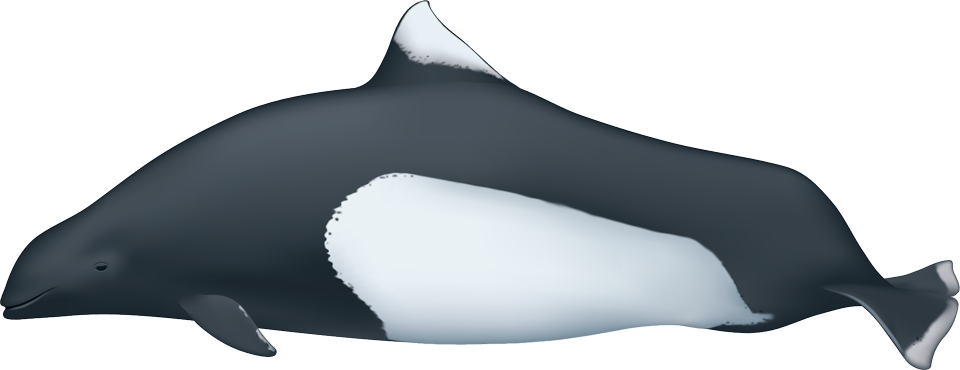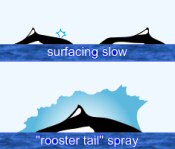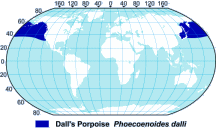Dalls Porpoise (original) (raw)
Dall's Porpoise
CLASS: Mammalia
ORDER: Cetacea
SUBORDER: Odontoceti
FAMILY: Phocoenidae
GENUS: Phocoenoides
SPECIES: dalli

This uniquely marked, black and white porpoise was named after the American naturalist W. H. Dall, who collected the first specimen of the type, which is now on display in the U. S. National Museum. It may be the fastest swimmer of all the small cetaceans and has been reported to reach speeds of 30 knots. It delights in bow riding with fast-moving vessels. As the porpoise dashes in at high speed, its head and back produce a bow wave called a "rooster tail", which creates a hollow cone allowing the animal to breathe while still under the surface of the water.
Physical Description
Dall's porpoise has an extremely robust and muscular body, especially through the mid-section, and the male is considerably thicker than the female. Its head is very small and rounded, appearing smaller than it really is because of the powerfully built body. The head slopes steeply to a short poorly defined beak. Its mouth is small and narrow, with 19 to 23 very small spade-shaped teeth in each side of the upper jaw and about 20 to 24 teeth in each side of the lower jaw. The teeth of Dall's porpoise are most unusual. Each tooth is separated by rigid, protruding growths called "gum teeth." Since its teeth are so small, these horny growths might be of help in grasping slippery food such as squid. The lower jaw extends slightly beyond the upper. In addition to a dorsal (upper) hump, there is a large hump located slightly forward of the flukes on the ventral (under) part of the body, which makes the animal look somewhat malformed. This ventral hump is more pronounced in adult males. There are few accounts of eye color in cetaceans, but Dall's porpoise is an exception; its eye has been described as having a black or dark blue iris and a deep, iridescent blue-green pupil.
Surface Characteristics
Color
Dall's porpoise is black with white markings. Though the color pattern varies with individual animals, most are basically black on the upper portions of the body, with large, oval-shaped white sides and white bellies. A band of white borders the flukes and the dorsal fin is usually patterned in white in varying shapes--but it may also be all black or all white.
Fins and Fluke
Its dorsal fin is placed slightly forward of the center of the body and is triangular in shape, and the flippers are very small and rounded at the tips. Flukes are small and pointed at the tips with a slight center notch.
Length and Weight
This cetacean is quite small, averaging 6 feet (1.8 m) for males with a maximum length of 7.5 feet (2.29m). Females average 6 feet (1.8 m) with a maximum length of 7 feet (2.1m). Weight averages 270 pounds (123 kg) for both males and females. Possible maximum weight is about 350 pounds (160 kg).
Feeding
Dall's porpoise eats a wide variety of prey species, depending on what's available within its range. In some areas it eats squid, but in other areas it may feed on small schooling fishes such as capelin, sardines, and herring. It is known to feed on certain deep-water species such as hake and deep-sea smelt, and in the northwest Pacific, lantern fish seem to be its primary food. It usually consumes about 28 to 30 pounds of food each day (12.7-13.6 kg), and does most of its feeding at night.
Mating and Breeding
Sexual maturity is generally reached at 6.5 feet (1.9 m) or at 8 years of age for males and about 5.5 feet (1.7 m) or 7 years for females. Calves average about 3.5 feet (1m) at birth and weigh about 55 pounds (25 kg). Calves may nurse for 2 years and the calving interval is probably about 3 years. Calving takes place primarily in summer, although births in U.S. Coastal populations can occur year-round. Gestation is between 10 to 12 months. Life expectancy is estimated to be less than 20 years.
Range Map
Distribution and Migration
Dall's porpoise are found only in the North Pacific, ranging from Baja California north to Alaska and the Bering Sea and across into Japanese waters, seemingly confined to colder waters with temperatures of less than 60 degrees F (15 C). Many are year-round residents over much of their range.
Natural History
These animals usually travel in small groups of 10 to 20, but as many as 200 may congregate while engaged in feeding. They are often found in the company of Pacific white-sided dolphins or pilot whales. Although known to bow ride, this small, fast species can often be elusive.
Status
Dall's porpoises are still numerous, but in urgent need of protection due to the large numbers caught in Japanese gillnet fisheries and by Japanese coastal whaling operations. Thousands are taken for food each year by the Japanese in their coastal waters, where 39,000, or about 1/3 of the western North Pacific population, were hand-harpooned in 1988. A serious threat also exists from the Japanese high seas salmon fishery, where a reported incidental take of 8,000 to 10,000 die during the 2-month fishing season. There may be an equal number of unreported catches. No one knows why Dall's porpoises become entangled in nets, since they do not feed on salmon. It is known, however, that some of the deep-sea species they do feed on come to the surface at night--which could put porpoises and prey on a collision course with the 1,700 miles of nets that Japanese fishermen set each night. It has also been suggested that their sonar capabilities do not detect the type of netting used (2" mesh monofilament, plastic and nylon). Others feel they may simply blunder into the nets (over 84,000 miles of nets are set during the fishing season). The majority of those caught in the nets are females and most are pregnant or nursing mothers. In addition, the squid fishery, which lasts 5 months out of each year, is an unknown factor in non-target species deaths. Efforts are now being made to regulate the annual losses of Dall's porpoise, but it is a very difficult task to assess population size, movements, numbers lost in nets, and the impact that these losses have on the total population in a wide expanse of ocean.
Bibliography
Balcomb, Kenneth, and Stanley Minasian. The World's Whales. Illustrated by Larry Foster. New York: Smithsonian Books, W. W. Norton, 1984.
Ellis, Richard. Dolphins and Porpoises. New York: Alfred A. Knopf, 1982
Leatherwood, S., R. Reeves, W. Perrin and W. Evans. Whales, Dolphins and Porpoises of the Eastern North Pacific and Adjacent Arctic Waters. U. S. Dept. of Commerce: NOAA Technical Report, NMFS Circular 444, July 1982.
Acknowledgements
Illustrations courtesy Uko Gorter, copyright ©2017 all rights reserved.
FACT SHEETS MAY BE REPRINTED FOR EDUCATIONAL OR SCIENTIFIC PURPOSES

